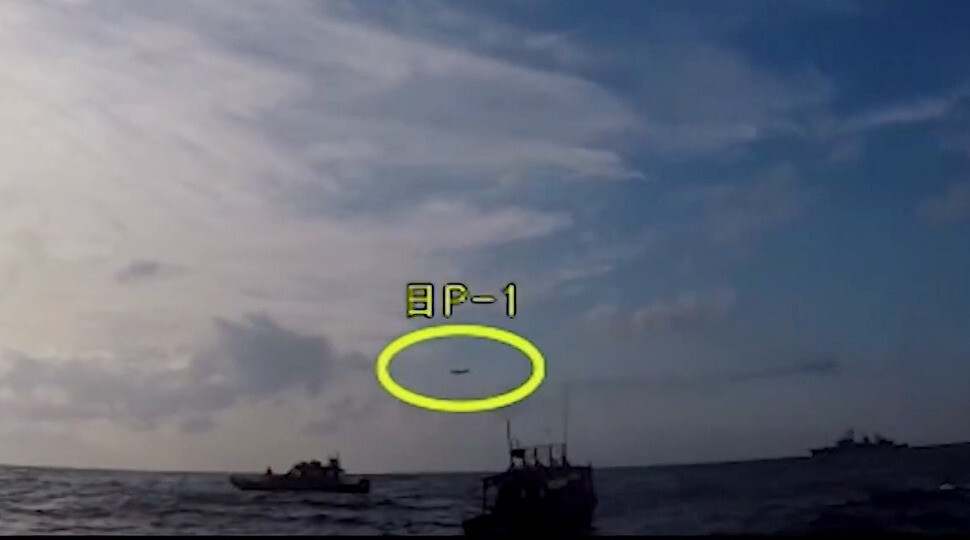hankyoreh
Links to other country sites 다른 나라 사이트 링크
S. Korea says military measures will be taken against Japanese patrol planes within 3nm of SK warships

A South Korean government warning that military measures would be taken in cases where Japanese patrol aircraft fly near South Korean warships prompted the Japanese government to demand a retraction, it was reported on Apr. 22.
The dispute over measures to prevent a reoccurrence of military tension is pointing to a repeat of the conflict that erupted between the two sides in response to an incident in the East Sea on Dec. 20 involving the alleged use of tracking radar by the destroyer Gwanggaeto the Great and a threatening flyby by a Japanese patrol aircraft.
“On Jan. 23, we summoned a military officer from the Japanese Embassy in South Korea to inform them that we would issue warning communications prior to operating signal tracking and illumination radar (STIR) in the event that a Japanese patrol aircraft threatens one of our warships again with a flyby,” a Ministry of National Defense (MND) senior official said. While the official gave no explanation on what would be considered a “flyby,” warning communications are reportedly issued in cases where Japanese patrol aircraft approach to within three nautical miles (around 5.5km) of a South Korean warship.

“In our message to the Japanese military officer, we unambiguously demanded that Japan stop its threatening low-altitude flights and devise measures to prevent them from occurring again in the future,” the official said.
The Japanese government reportedly demanded a retraction of the warning, which it took as indicating that South Korean military could potentially aim fire control radar at its patrol aircraft. The “fire control radar” referred to by Japan is the equivalent of South Korea’s tracking radar. The Japanese Ministry of Defense (MOD) also reportedly demanded a retraction in closed-door working-level meetings with the MND on Apr. 10–11, but the MND simply reiterated its stance.
In an earlier piece titled “The South Korean Military’s New Guidelines: A Shadow on Security Cooperation,” Japan’s Yomiuri Shimbun newspaper previously reported that Seoul had “notified the Japanese government that it would direct fire control radar in cases where Japanese military aircraft approached to within three nautical miles of South Korean warships.”
“The guidelines in question were said to be applied to all countries apart from the US, and with South Korea-Japan relations souring, they appear to be measures taken by South Korea to emphasize its militant stance toward Japan,” the newspaper wrote.
The MND issued a response statement that said, “While it is true that we explained to Japan about our armed forces’ military measures and approach to prevent the possibility of unintended clashes on the seas between South Korea and Japan, it is not true that we informed Japan of a response manual including detailed operational procedures.”
At the same time, the ministry expressed “dismay at [Japan] disclosing information that was supposed to remain undisclosed.”
Previously, Japan claimed that the South Korean Navy destroyer Gwanggaeto the Great aimed fire control radar at a Japanese patrol aircraft during the vessel’s rescue of a North Korean ship in the East Sea on Dec. 20. In response, the MND alleged that the aircraft had engaged in a threatening flyby and subsequently amended its response guidelines. The new guidelines reportedly included more sternly worded warning communications in cases where foreign patrol aircraft enter within a specific distance of South Korean warships, as well as plans for weapons system operation and the mobilization of Lynx helicopters used on the vessels for submarine search efforts.
By Yoo Kang-moon, senior staff writer
Please direct comments or questions to [english@hani.co.kr]

Editorial・opinion
![[Column] Season 2 of special prosecutor probe may be coming to Korea soon [Column] Season 2 of special prosecutor probe may be coming to Korea soon](https://flexible.img.hani.co.kr/flexible/normal/500/300/imgdb/original/2024/0426/3317141030699447.jpg) [Column] Season 2 of special prosecutor probe may be coming to Korea soon
[Column] Season 2 of special prosecutor probe may be coming to Korea soon![[Column] Park Geun-hye déjà vu in Yoon Suk-yeol [Column] Park Geun-hye déjà vu in Yoon Suk-yeol](https://flexible.img.hani.co.kr/flexible/normal/500/300/imgdb/original/2024/0424/651713945113788.jpg) [Column] Park Geun-hye déjà vu in Yoon Suk-yeol
[Column] Park Geun-hye déjà vu in Yoon Suk-yeol- [Editorial] New weight of N. Korea’s nuclear threats makes dialogue all the more urgent
- [Guest essay] The real reason Korea’s new right wants to dub Rhee a founding father
- [Column] ‘Choson’: Is it time we start referring to N. Korea in its own terms?
- [Editorial] Japan’s rewriting of history with Korea has gone too far
- [Column] The president’s questionable capacity for dialogue
- [Column] Are chaebol firms just pizza pies for families to divvy up as they please?
- [Column] Has Korea, too, crossed the Rubicon on China?
- [Correspondent’s column] In Japan’s alliance with US, echoes of its past alliances with UK
Most viewed articles
- 1[Column] Season 2 of special prosecutor probe may be coming to Korea soon
- 2‘We must say no’: Seoul defense chief on Korean, USFK involvement in hypothetical Taiwan crisis
- 3No good, very bad game for Korea puts it out of Olympics for first time since 1988
- 4Division commander ordered troops to enter raging flood waters before Marine died, survivor says
- 5Is Japan about to snatch control of Line messenger from Korea’s Naver?
- 6Korea’s 1.3% growth in Q1 signals ‘textbook’ return to growth, says government
- 7Is N. Korea threatening to test nukes in response to possible new US-led sanctions body?
- 8[Editorial] Korea’s surprise Q1 growth requires objective assessment, not blind fanfare
- 9[Editorial] New weight of N. Korea’s nuclear threats makes dialogue all the more urgent
- 10‘Weddingflation’ breaks the bank for Korean couples-to-be